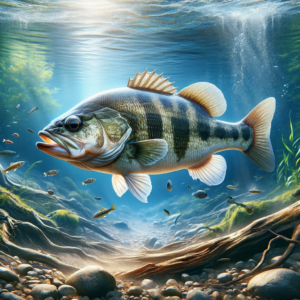Have you ever wondered if smallmouth bass feed on bluegill? It’s an intriguing question for anglers and researchers alike. Smallmouth bass are known for their voracious appetites, but are they specifically targeting bluegill as a food source? In this article, we will explore the feeding habits of smallmouth bass and delve deeper into their relationship with bluegill.
Smallmouth bass are opportunistic feeders, meaning they will eat whatever is readily available and can fit into their mouths. While they have a diverse diet that includes insects, crayfish, and other small fish, bluegill can definitely be on the menu. Bluegill are a common prey item for smallmouth bass, as they are abundant in many freshwater ecosystems.
However, smallmouth bass do not exclusively feed on bluegill. They are adaptable predators that will take advantage of any available food source. Depending on the location and season, smallmouth bass may also target other fish species, such as shad or minnows. It’s important to note that the availability of bluegill as a food source can vary depending on the specific ecosystem and the size of the bass population.
In conclusion, while smallmouth bass do feed on bluegill, they are not solely reliant on this particular prey species. Smallmouth bass are adaptable predators that will eat a variety of food sources, depending on what is available to them. Understanding the feeding habits of smallmouth bass can be crucial for anglers looking to target them, as it can help them choose the most effective lures and baits.
Overview of Smallmouth Bass
Smallmouth bass (Micropterus dolomieu) is a popular freshwater game fish that is native to North America. It is renowned for its fighting ability and is highly sought after by anglers. Smallmouth bass inhabits rivers, streams, and lakes, primarily in the eastern and central regions of the United States and Canada. These fish are known for their aggressive feeding behavior and are opportunistic predators, consuming a wide range of prey items. One of the most common prey species for smallmouth bass is the bluegill (Lepomis macrochirus).
Physical Characteristics
Smallmouth bass are often called “bronzebacks” due to their distinctive coloration, which ranges from olive-brown to bronze on their backs and sides. They have a streamlined body shape, with a sloping forehead and a large, deeply forked tail. On average, smallmouth bass range in size from 10 to 20 inches, although larger individuals have been recorded. They can weigh between 1 to 5 pounds, with some reaching weights of up to 7 pounds. Smallmouth bass have a mouth equipped with sharp teeth and a lower jaw that extends beyond the upper jaw, allowing them to capture and consume their prey effectively.
Habitat and Distribution
Smallmouth bass prefer clear, cool, and well-oxygenated waters. They can be found in various aquatic habitats, including rivers, streams, lakes, and reservoirs. Smallmouth bass thrive in rocky areas with ample cover, such as submerged logs, boulders, and vegetation. They are particularly abundant in areas with moderate to swift currents, where they utilize these structures to ambush and capture their prey.
Smallmouth bass have a wide distribution across North America. They are native to the Great Lakes region and the St. Lawrence River basin, as well as various river systems in the Midwest and Southeast. Due to their popularity as a game fish, they have been introduced to many other parts of the United States and Canada, including the Pacific Northwest and the southern states.
Feeding Behavior
Smallmouth bass are voracious predators that primarily feed on small fishes, crayfish, insects, and other aquatic organisms. They exhibit a sit-and-wait feeding strategy, where they ambush their prey from a concealed location and then strike with lightning speed. Smallmouth bass also engage in opportunistic feeding, taking advantage of any available food source.
Bluegill as Prey
Characteristics of Bluegill
The bluegill is a common prey species for smallmouth bass. Bluegill are members of the sunfish family (Centrarchidae) and are widespread throughout North America. They are known for their characteristic blue coloration on their gill covers, hence their name. Bluegill have a compressed body shape, with a deep and round shape, and can grow up to 12 inches in length. They primarily feed on aquatic insects, small crustaceans, and zooplankton.
Frequency of Bluegill in Smallmouth Bass Diet
Research has shown that bluegill are a significant component of smallmouth bass diet in many waters where they coexist. Smallmouth bass can consume a considerable number of bluegill, especially when they are abundant in their habitat. The frequency of bluegill in the diet of smallmouth bass can vary depending on factors such as prey availability, habitat characteristics, and individual feeding preferences.
Impact of Bluegill Consumption on Smallmouth Bass
The consumption of bluegill by smallmouth bass can have various impacts on both species. As prey, bluegill provides a valuable source of nutrition for smallmouth bass, contributing to their growth and reproductive success. The availability of bluegill as a prey item can directly influence the population dynamics of smallmouth bass, as their abundance may affect the growth rates and overall condition of the bass. Additionally, the interaction between smallmouth bass and bluegill can have broader ecological implications, such as the regulation of bluegill populations and the overall structure and functioning of the aquatic ecosystem.
Feeding Habits of Smallmouth Bass
Dietary Preferences
While smallmouth bass have a diverse diet, they exhibit preferences for certain prey items. In addition to bluegill, smallmouth bass commonly consume other species of fish, including minnows, shiners, and darters. They also feed on crayfish, insects, and other invertebrates. The exact composition of their diet can vary depending on factors such as prey availability, habitat characteristics, and seasonal changes.
Factors Affecting Feeding Behavior
Several factors can influence the feeding behavior of smallmouth bass. Water temperature, for example, plays a crucial role in their activity level and metabolic rate, which can directly impact their feeding behavior. Smallmouth bass are more active and exhibit increased feeding rates in warmer water temperatures. The availability and abundance of prey items also play a significant role in their feeding behavior. In areas with high prey density, smallmouth bass may exhibit a more selective feeding behavior, targeting specific prey species.
Importance of Prey Availability
The availability of prey is a crucial factor in the survival, growth, and reproductive success of smallmouth bass populations. Prey availability can fluctuate seasonally and spatially, influenced by factors such as water temperature, habitat characteristics, and interactions with other predator and prey species. Smallmouth bass populations are highly dependent on a stable and diverse prey base for their continued growth and survival.
Predator-Prey Relationships
Understanding Predator-Prey Interactions
Predator-prey relationships are complex and dynamic, with both species exerting selective pressures on each other. Smallmouth bass and bluegill engage in a predator-prey relationship, where the feeding behavior of one species impacts the population dynamics and behavior of the other. Predation by smallmouth bass can influence the population size and structure of bluegill, while the availability of bluegill as prey can impact the feeding behavior and habitat selection of smallmouth bass.
Factors Influencing Smallmouth Bass Prey Selection
Smallmouth bass exhibit a certain degree of selectivity when it comes to their prey selection. Factors such as prey size, behavior, and vulnerability influence their feeding preferences. Smallmouth bass tend to target smaller prey items that are more easily captured and consumed. They may also exhibit preferences for certain prey behavior, such as the movement patterns of injured or struggling fish. Additionally, the availability and abundance of a particular prey species can influence the feeding preferences of smallmouth bass.
Predator Adaptations for Prey Capture
Smallmouth bass possess several adaptations that enhance their ability to capture and consume their prey. Their streamlined body shape and strong muscular structure allow them to move quickly and effectively in the water, enabling them to stalk and ambush their prey. Their sharp teeth and powerful jaws facilitate the capture and ingestion of a wide range of prey items. Furthermore, their excellent eyesight and lateral line system enable them to detect prey movements and vibrations in the surrounding water.
Smallmouth Bass and Bluegill Interaction
Observations of Bluegill Consumption by Smallmouth Bass
Field observations and studies have provided evidence of smallmouth bass actively feeding on bluegill. Anglers often report catching smallmouth bass with bluegill in their stomachs. Researchers have also conducted studies where they use stomach contents analysis and other methods to quantify the consumption of bluegill by smallmouth bass. These studies indicate a significant level of predation on bluegill by smallmouth bass in certain habitats and under specific conditions.
Effects of Bluegill Availability on Smallmouth Bass Population
The availability of bluegill as a prey item can have important implications for smallmouth bass populations. In habitats where bluegill are abundant, smallmouth bass may exhibit higher growth rates and overall body condition due to the ample food supply. Conversely, in areas where bluegill are scarce or unavailable, smallmouth bass may experience reduced growth rates and are more likely to utilize alternative prey sources. The availability of bluegill can influence the population dynamics and behavior of smallmouth bass, ultimately shaping their overall abundance and distribution.
Competition between Bluegill and Smallmouth Bass
Smallmouth bass and bluegill can compete for similar resources in their shared habitats, such as food and shelter. Bluegill are also known to periodically consume smallmouth bass eggs and fry, further intensifying the competition between the two species. The balance of competition and predation between smallmouth bass and bluegill can vary depending on factors such as prey availability, habitat structure, and population densities. These interactions play a role in shaping the population dynamics and community structure of both species.
Factors Influencing Bluegill Consumption
Seasonal Variation in Prey Availability
The availability of bluegill as a prey item can vary seasonally. Bluegill populations may undergo fluctuations in abundance and distribution due to factors such as spawning behavior, water temperature, and prey availability. Smallmouth bass consumption of bluegill may also exhibit seasonal patterns, with increased predation during periods of higher bluegill abundance or vulnerability.
Size and Age of Smallmouth Bass
The size and age of smallmouth bass can influence their prey selection and consumption patterns. Smaller individuals may primarily feed on smaller prey items, such as insects and small crustaceans. As they grow larger, their diet encompasses larger prey items, including bluegill. The ability of smallmouth bass to consume bluegill may also depend on their overall body size and mouth morphology, as larger individuals can more effectively capture and consume larger prey.
Predator-Prey Size Ratio
The size ratio between predators and their prey can impact their ability to capture and consume each other. Smallmouth bass may be limited in their ability to consume larger bluegill individuals due to the size discrepancy between the predator and its prey. However, smaller bluegill individuals may be more vulnerable to predation by smallmouth bass. The predator-prey size ratio can affect the overall dynamics of the smallmouth bass-bluegill interaction and may determine the level of predation on bluegill.
Methods of Studying Smallmouth Bass Feeding Habits
Field Observation
Field observations provide valuable insights into the feeding habits of smallmouth bass. Researchers can observe smallmouth bass in their natural habitats, noting their hunting behavior, prey selection, and feeding rates. These observations can help determine the frequency and extent of bluegill consumption by smallmouth bass.
Analysis of Stomach Contents
Analysis of stomach contents is a common method used to study the diet of smallmouth bass. By dissecting captured individuals and examining the contents of their stomachs, researchers can identify and quantify the prey items consumed by smallmouth bass. This method provides direct evidence of bluegill consumption and allows for comparisons of prey composition between different habitats and seasons.
Technological Advances
Technological advancements have greatly expanded our ability to study the feeding habits of smallmouth bass. Acoustic telemetry and tracking devices can be used to monitor the movements and behavior of smallmouth bass in real-time, providing insights into their feeding behavior and habitat preferences. Sonar and underwater cameras allow researchers to observe the interaction between smallmouth bass and bluegill in their natural environment, providing a more detailed understanding of their feeding habits.
Conservation Implications
Role of Bluegill in Ecosystem
Bluegill play an essential role in the freshwater ecosystem, serving as a prey species for various predators, including smallmouth bass. The abundance and availability of bluegill can influence the population dynamics and behavior of smallmouth bass, as well as other predator and prey species. Maintaining healthy bluegill populations is crucial for the overall balance and functioning of the ecosystem.
Impact of Prey Depletion on Smallmouth Bass
The depletion of prey resources, such as bluegill, can have detrimental effects on smallmouth bass populations. A decline in bluegill abundance may result in reduced growth rates, decreased reproductive success, and increased competition among smallmouth bass individuals. It is essential to manage and conserve prey resources to ensure the long-term sustainability of smallmouth bass populations.
Management Strategies
Effective management strategies can help maintain a healthy balance between smallmouth bass and bluegill populations. Implementing regulations such as size and bag limits can help protect both species and their habitats. Additionally, habitat restoration and conservation efforts can enhance the availability of suitable spawning and rearing habitats for both smallmouth bass and bluegill. Monitoring and research programs can provide valuable data on the feeding habits and population dynamics of smallmouth bass, allowing for informed management decisions.
Conclusion
In conclusion, smallmouth bass do feed on bluegill, with the frequency of bluegill consumption varying depending on factors such as prey availability, habitat characteristics, and individual feeding preferences. The predation of bluegill by smallmouth bass has important implications for both species, influencing the population dynamics, growth rates, and overall abundance of smallmouth bass. Understanding the interactions between smallmouth bass and bluegill is vital for effective management and conservation efforts. By implementing sustainable fishing practices and ensuring the preservation of prey resources, we can maintain healthy smallmouth bass and bluegill populations, contributing to the overall health and balance of freshwater ecosystems.




